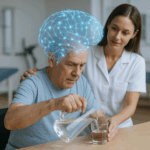Physiotherapy Treatment Protocol for Chronic Adhesive Capsulitis
Overview of Conditions:
Chronic adhesive capsulitis, or frozen shoulder, is characterized by progressive stiffening and thickening of the glenohumeral joint capsule, leading to pain, restricted range of motion (ROM), and difficulties in performing functional tasks. In the chronic stage, which follows the painful (freezing) phase, the stiffness persists, though pain decreases. Key clinical features include significant limitation in external rotation, abduction, and flexion, along with difficulty performing overhead tasks. Proper management is essential to gradually restore ROM, control pain, and regain shoulder function.
Assessment and Evaluation:
- History:
- Chronic symptoms lasting 6 months to 2 years or longer.
- Gradual onset of shoulder pain and stiffness with little ROM improvement despite conservative treatments.
- Presence of comorbid conditions (e.g., diabetes mellitus, thyroid disorders) or prior shoulder injury contributing to the chronicity.
- Pain Assessment:
- Use of the Visual Analog Scale (VAS) or Numeric Pain Rating Scale (NPRS) to monitor pain intensity, with a focus on movement-induced pain, especially in end-range motions.
- Pain assessment during functional tasks and passive movements.
- Physical Examination:
- Postural Assessment: Identification of abnormal postures (e.g., slumped posture) and muscle guarding.
- ROM Testing: Significant restrictions, particularly in external rotation, abduction, and flexion.
- Strength Testing: Weakness in shoulder stabilizers due to pain and limited movement.
- Special Tests:
- Glenohumeral Joint Passive ROM: Check for capsular tightness and severe restrictions in external rotation and abduction.
- Painful Arc Test: Pain between 60° and 120° of abduction suggests shoulder joint or soft tissue pathology.
Goal Setting:
- Short-Term Goals:
- Pain Control: Reduce pain to a manageable level (VAS ≤ 3) during movements and functional tasks.
- Increase ROM: Improve passive shoulder ROM, especially in external rotation, abduction, and flexion.
- Muscle Relaxation: Alleviate muscle guarding in the shoulder and surrounding muscles.
- Maintain Functional Capacity: Minimize the impact of shoulder stiffness on daily tasks.
- Long-Term Goals:
- Restore ROM: Aim for full or near-full ROM, particularly focusing on external rotation, abduction, and flexion.
- Strengthening: Strengthen the rotator cuff and scapular stabilizers to support the shoulder and prevent instability.
- Functional Recovery: Achieve full functional recovery, including overhead activities and lifting.
- Prevent Recurrence: Educate the patient on maintaining shoulder mobility and strength to prevent relapse.
Recommended Treatment:
Electrotherapy:
- Transcutaneous Electrical Nerve Stimulation (TENS):
- Indication: Pain relief and muscle relaxation.
- Parameters:
- Frequency: 80-120 Hz.
- Intensity: Sub-threshold, comfortable intensity.
- Pulse Width: 100-300 µs.
- Duration: 20-30 minutes, 2-3 times daily.
- Mechanism: Stimulates sensory nerves to block pain signals, alleviating discomfort and muscle spasms.
- Interferential Therapy (IFT):
- Indication: Deep pain relief and improved circulation.
- Parameters:
- Frequency: 4,000 Hz carrier frequency modulated at 80-150 Hz.
- Duration: 20-30 minutes per treatment area.
- Mechanism: Enhances blood flow, reduces pain, and supports soft tissue healing.
- Class 4 LASER Therapy:
- Indication: Tissue healing and inflammation reduction.
- Parameters:
- Wavelength: 800-900 nm.
- Power: 5-10 W.
- Duration: 5-10 minutes per treatment area.
- Mechanism: Increases cellular metabolism, reduces pain, and accelerates tissue repair, improving tissue flexibility and reducing stiffness.
- Ultrasound Therapy:
- Indication: Decreases fibrosis, relieves pain, and enhances tissue flexibility.
- Parameters:
- Frequency: 1 MHz for deeper penetration.
- Intensity: 1.0-1.5 W/cm².
- Duration: 8-10 minutes per treatment area.
- Mechanism: Promotes collagen production, enhances blood flow, and aids in breaking down adhesions and improving mobility.
Thermotherapy:
- Moist Heat Packs:
- Indication: Reduce muscle tension and increase tissue extensibility.
- Application: Apply heat for 15-20 minutes before exercises or manual therapy.
- Mechanism: Heat relaxes muscle tissue, increases blood flow, and prepares the shoulder for ROM exercises and mobilizations.
Manual Therapy:
- Joint Mobilization (Grade III-IV):
- Indication: Restore ROM and reduce joint stiffness.
- Technique: Use oscillatory or sustained mobilizations to address capsular restrictions.
- Mechanism: Mobilizations stretch the joint capsule and improve synovial fluid movement, reducing stiffness and improving ROM.
- Myofascial Release:
- Indication: Address muscle tightness in the rotator cuff and upper trapezius.
- Technique: Apply sustained pressure on tight muscles to release fascial adhesions.
- Mechanism: Reduces pain, increases tissue flexibility, and facilitates greater ROM.
Exercise Therapy:
- Range of Motion (ROM) Exercises:
- Exercise: Progress from passive to active-assisted, then active ROM exercises, focusing on external rotation, abduction, and flexion.
- Duration: 3-5 sets, 3-5 repetitions, 3-4 times daily.
- Mechanism: Improves joint mobility and prevents further capsular fibrosis.
- Strengthening Exercises:
- Exercise: Introduce strengthening for rotator cuff and scapular stabilizers, starting with isometric exercises and progressing to dynamic strengthening.
- Duration: 2-3 sets, 10-12 repetitions, 3 times weekly.
- Mechanism: Strengthens the rotator cuff and stabilizers to support the shoulder and prevent future injury.
- Stretching:
- Exercise: Gentle stretching for shoulder capsule flexibility, focusing on external rotation and abduction using PNF or hold-relax techniques.
- Duration: Hold stretches for 20-30 seconds, 2-3 repetitions, 2-3 times daily.
- Mechanism: Increases joint flexibility and helps break down adhesions in the shoulder capsule.
Precautions:
- Electrotherapy: Avoid areas with open wounds, over the heart, or on patients with pacemakers. Caution with significant edema or acute inflammation.
- Thermotherapy: Avoid heat application immediately after trauma or during acute inflammation (first 48 hours). Monitor for patient comfort.
- Manual Therapy: Avoid aggressive mobilizations that may cause excessive pain or irritation. Monitor patient tolerance.
- Exercise Therapy: Ensure exercises are within the patient’s pain tolerance and progress gradually to avoid exacerbating symptoms.
Reassessment and Criteria for Progression/Change in Care Plan:
- Pain Reduction: If pain persists despite 6-8 weeks of management, consider corticosteroid injections, advanced imaging, or referral for surgical options.
- ROM: If there is limited improvement after 4-6 weeks, consider more aggressive manual therapy or interventions like “stretching under anesthesia.”
- Strength: Transition to more functional strengthening exercises once pain is controlled and ROM improves.
Disclaimer and Note:
Treatment options should be chosen wisely and appropriately. In cases where multiple options are available (e.g., electrotherapy), any one modality can be selected based on availability and patient appropriateness. It is important to consult a qualified healthcare provider for an individualized treatment plan.
References:
- Walker, M. L., et al. (2022). “Chronic Adhesive Capsulitis: Pathophysiology and Management.” Journal of Orthopaedic & Sports Physical Therapy, 52(8), 512-518. https://doi.org/10.2519/jospt.2022.10820
- Cleland, J. A., & Vance, C. (2020). “Management of Adhesive Capsulitis: A Review of the Evidence.” Journal of Manual & Manipulative Therapy, 28(1), 12-20. https://doi.org/10.1080/10669817.2020.1720228
- Hopkins, A., et al. (2021). “Adhesive Capsulitis and Physiotherapy Intervention: A Systematic Review.” British Journal of Pain, 35(4), 507-518. https://doi.org/10.1177/2049463721100579






